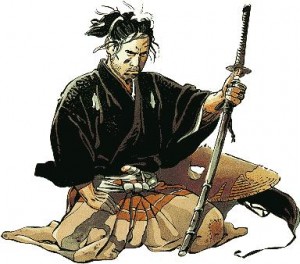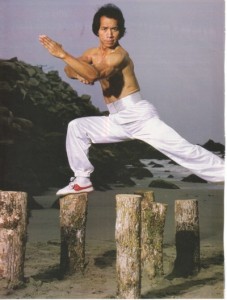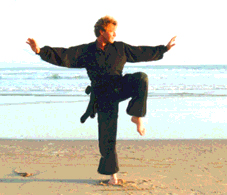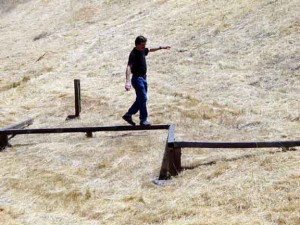The Real Sixth Sense Balance in the Martial Arts
Balance in the Martial Arts
One day a young samurai approached a revered teacher of swordsmanship and begged acceptance as a student.
“You must do everything I ask you without question.” The teacher warned. The samurai agreed without hesitation.
“Hai.” Said the teacher “Go to the Dojo and walk along the edge of the Tatami by placing one foot in front of the other.”
Perplexed the samurai did as he was told but after a week of this practise, he became impatient to pick up a sword. After the tenth day, he could take no more and angrily questioned the teacher when they would begin serious training.
“Very well.” Said the teacher. “Tonight we will begin serious training.”
That night under a full moon, the teacher took the Samurai up into the mountains until they came to a deep and narrow gorge. Spanning the gorge was a fallen tree.
“Here we begin training.” Said the teacher. “Cross over the gorge.”
“But the tree is too narrow.” Said the samurai.
“It is much wider than the edge of a Tatami.” Replied the teacher.
The Samurai jumped up on the fallen tree but as he began to step forward the dim moonlight and the sound of rushing water beneath him seemed to pull him off balance.
“I cannot cross.” Said the Samurai.
“Well then, how can you expect to master the sword when haven’t yet mastered walking?” Said the teacher.
Japanese Folk Tale
At first glance, the above tale, like many such `teaching tales’ from the Far East, illustrates a simple lesson in humility. However, a deeper meaning to the story is revealed when you ask the question, why couldn’t the Samurai cross the gorge? The answer is that the Samurai hadn’t mastered his sixth sense.
Before modern medicine, man generally recognized that he had five senses, sight sound, touch, taste and smell. The so-called sixth sense was thought to be an extra sense hence the term Extra Sensory Perception or ESP. It is now known that we have three other senses, balance, proprioception, and a sense of direction. Anything paranormal would have to be moved down the list to the `ninth sense’.
The story indeed teaches a lesson about the sixth sense, balance. The ability to master one’s senses and control perception is an important skill underlying every other. In the case of the Samurai and the gorge, it was his inability to master his perception of balance that prevented him from crossing.
The sense of balance is one most of us take for granted, yet in the traditions of every martial arts discipline, mastery of balance played a primary role in developing fighting skills. One reason is that in battle the greatest strategic advantage lies in mobility. For the martial artist, mobility requires both strong legs and excellent balance.
To master balance, one first needs to understand how the sense of balance is accomplished.
Balance is controlled by a combination of three senses; the vestibular, vision, and proprioception.
The sense of up and down is provided by the vestibular system located within the inner ear. It consists of three semicircular hollow tubes that are set at angles to each other. These tubes are filled with liquid that flows through the tubes depending on head tilt and movement. Lining the tubes are hair-like nerve endings that, when stimulated by the movement of the fluid, transforms this motion into a neural signal. This provides information on the position of the head, telling the brain when the head is tilted forward, backward, and side to side, similar to a carpenter’s level. While the vestibular system supplies information about head position, it does not communicate the overall positioning of the body itself. This information comes from two other sources: vision and proprioception.
Vision tends to dominate and override all other senses including our sense of balance. You can test how much vision influences your balance by first standing on one foot with your eyes open, and then with the eyes closed. Most people will begin to lose their balance with their eyes closed. However, vision is not essential to balance and in certain situations, its input is detrimental to performing complex physical movements. Gymnasts, acrobats, high platform divers, and martial artists must train their nervous system not to rely on the eyes for balance.
For example, dancers and figure skaters, when performing pirouettes, focus their eyes on a point in the horizon. As their body spins, the head and eyes remain focused on that spot until the neck will not twist any further, then the head turns around quickly ahead of the body and again focuses on that same spot. If you allowed the head to spin in tandem with the body, the overwhelming visual and vestibular sensations would cause immediate dizziness and disorientation. (Notice young children spinning and falling to the ground.) The same principle is needed to execute a spinning kick or hand technique. The eyes must focus on the target, while the body feels it way through the movement.
This feeling your way through a movement is done by the third sense involved in balance, Proprioception. (Also known as the kinaesthetic sense) This sense is the result of the combined information the brain receives from the Golgi tendon organs. These are sensors within every muscle that measures the amount of tension each muscle is exerting. This information enables us to sense physical movement and posture, as well as how heavy an object is, or how hard to throw a ball. It is also the sense of being `in’ your body.
Information received from all three senses is processed and directions are sent to the various muscles groups to maintain balance. Therefore, we know why the Samurai could not cross the gorge; he could not suppress his visual input over that of his proprioception that caused him to lose his balance on the log.
Training Methods: Balance
Now that we understand how balance is accomplished we can learn ways of improving it. The following exercises are aimed at improving the sense of proprioception while reducing the reliance on visual cues. In addition, balance training works the body’s stabilizer muscles. These are smaller muscles that refine movement and are responsible for what can be described as grace and fluidity.
This exercise is similar to those done in modern dance, ballet, figure skating, and gymnastics. While standing on one leg, bend the other leg and raise the thigh upward so that it is parallel to the floor. Hold this position for the count of ten. Still keeping your thigh horizontal, rotate the thigh out 90 degrees to the side of your body, hold for a count of ten. Then lean forward and bring the leg behind you in what ballet would term an Arabesque, and hold for a count of ten. Repeat with other leg.
Gradually increase the length of time you hold out the leg until you are able to hold it for one minute. When you are able to hold it out for one minute then repeat the same exercise, this time with the raised leg held straight.
Finally, practice the same movements but with eyes closed. If you can accomplish this with eyes closed and without losing balance you will have mastered this exercise.
Place a ten foot, 4″ x 4″ or equivalent, beam on the ground and walk across it each day. When you are able to walk across the beam without the least loss of balance, close your eyes and repeat. For the next stage, raise the beam off the ground a foot. When you feel comfortable crossing at this height with your eyes closed, raise the beam higher still. When the beam is six or more feet off the ground, and you can easily walk along it, you have mastered this exercise.
If you don’t have a place for the beam you can always practice walking along curbs if you don’t mind the strange looks it attracts.
Single Leg Squats
Hold one leg out 90 degrees and garb the foot with your hand. Keeping the knee straight, slowly lower yourself into a squat until your buttocks rest against your calve. Then stand straight up again. These exercises require both excellent balance and leg strength.
Varied Terrain
In China and rural Japan, much time is spent training outdoors, in the parks, along beaches, and in the mountains. These varied conditions improve balance and stability to deeper levels than the uniform flat surfaces we usually train and spend our working days on
All martial artists should train under different terrains and conditions. By expanding one’s experience with varied conditions, one is better able to react and move under a greater number of combat situations. Practice your forms and drills on hills, along the beach, on rocky ground, in the snow, and during a rainstorm. The first thing you will notice is the incredible strain this puts on the legs spurring the development of stronger leg muscles. One also learns to move more perfectly balanced since the ground is often unreliable being either to slippery or too entangled to allow any degree of error.
Conclusion
While we all love to perform the acrobatic, the dazzling, and the swift movements, in the end, like the old masters that came before, we find ourselves returning to the beginning, struggling to master the first skills we learned as a children, the simple skills of standing and walking.


